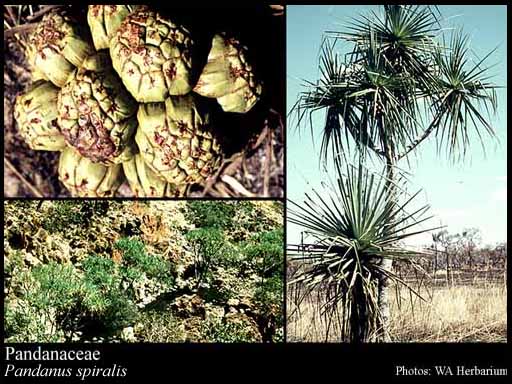- Reference
- Prodr.Fl.Nov.Holland. 340 (1810)
- Name Status
- Current

Scientific Description
Common name. Screw-pine Family.
Habit and leaf form. Trees, shrubs, and lianas. Rhizomatous. Self supporting (usually with prop roots at the base of the stem), or epiphytic, or climbing; when climbing, root climbers. Stem growth conspicuously sympodial (appearing dichtomous). Pachycaul. Helophytic, or mesophytic (often maritime). Leaves medium-sized to very large; alternate; spiral (appearing so, through torsion of the stem), or tristichous (usually, in fact), or four-ranked (rarely); leathery; imbricate; sessile; sheathing. Leaf sheaths with free margins. Leaves simple. Leaf blades entire; usually linear, or lanceolate; parallel-veined; without cross-venules. Leaves eligulate. Vernation plicate. Vegetative anatomy. Plants without silica bodies. Stem anatomy. Secondary thickening absent (with compound vascular bundles).
Reproductive type, pollination. Fertile flowers functionally male, or functionally female, or hermaphrodite and functionally male, or hermaphrodite and functionally female. Unisexual flowers present. Plants dioecious, or polygamodioecious. Female flowers with staminodes, or without staminodes. Anemophilous, entomophilous, ornithophilous, and cheiropterophilous (mostly by wind).
Inflorescence and flower features. Flowers aggregated in ‘inflorescences’; in panicles, in racemes, and in heads (often crowded into dense panicles). Inflorescences terminal; spatheate. Flowers minute, or small. Perianth of ‘tepals’ (?—Sararanga), or absent (Freycinetia and Pandanus); 3–4 (Sararanga); 1 -whorled; when present, joined (cupuliform); in Sararanga, more or less sepaloid. Fertile stamens present, or absent (female flowers). Androecium of male-fertile flowers 10–100 (?—‘many’, the situation in Freycinetia and Pandanus complicated by the fact that homologies are so unclear that it is not possible with any certainty to distinguish ‘flowers’ from aggregates of flowers). Androecial members branched (ostensibly), or unbranched; free of the perianth; variously coherent (often with stemonophores), or free of one another (and then no trace of flower structure discernable). Stamens 10–100 (‘many’ — regardless of what constitutes a single flower); filantherous, or with sessile anthers. Anthers basifixed; dehiscing via longitudinal slits; appendaged (via apical prolongation of the connective), or unappendaged. Fertile gynoecium present, or absent (male flowers, but these often grouped around pistillode). Gynoecium (1–)80 carpelled. The pistil 1–100 celled (to ‘many’). Gynoecium monomerous (rarely), or apocarpous to syncarpous; of one carpel (rarely), or eu-apocarpous to eu-syncarpous (syncarpous in Sararanga and Freycinetia, carpels free or connate in Pandanus); superior. Carpel (when apocarpous or unilocular) 1–5 ovuled. Placentation when apocarpous or one-carpelled marginal, or basal. Ovary unilocular, or plurilocular; when syncarpous 1 locular (in Freycinetia), or 2–100 locular (i.e. to ‘many’). Placentation when bi- multilocular axile (Freycinitia), or basal. Ovules when plurilocular 1–5 per locule (carpels uniovulate in Pandanoideae, several-ovuled in Freycinetioideae); anatropous.
Fruit and seed features. Fruit fleshy to non-fleshy; more or less an aggregate, or not an aggregate. The fruiting carpels (when apocarpous) coalescing into a secondary syncarp, or not coalescing. The fruiting carpel indehiscent; drupaceous (12–80 in Sararanga). Fruit when syncarpous, indehiscent; when syncarpous, a berry. Gynoecia of adjoining flowers generally combining to form a multiple fruit. The multiple fruits coalescing (to varying extents, in Pandanus), or not coalescing. Fruit 1 seeded. Seeds endospermic. Endosperm oily, or not oily. Seeds minute; with starch. Embryo well differentiated (small). Cotyledons 1. Embryo straight. Seedling. Hypocotyl internode present. Mesocotyl absent. Seedling collar not conspicuous. Cotyledon hyperphyll compact; non-assimilatory. Coleoptile absent. Seedling cataphylls absent. First leaf dorsiventral. Primary root ephemeral.
Geography, cytology, number of species. World distribution: Southwest tropical Africa, Madagascar, India to Thailand, Malaysia and Australia. X = 30 (with aneuploidy). 700 species.
Economic uses, etc. Pandanus leaves are used for thatch, matting, clothing and containers, and the immature fleshy perianths of some species are edible.